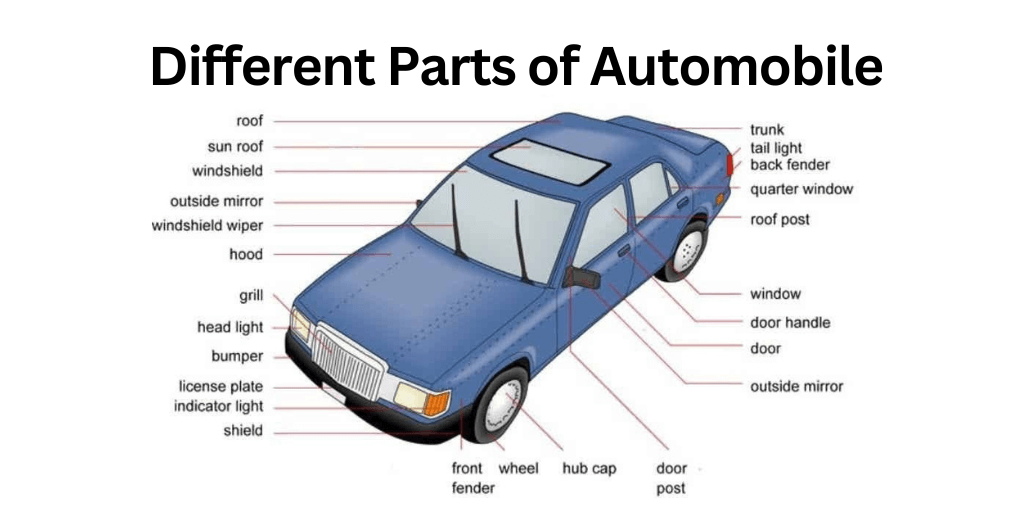Understanding the different parts of automobile allows you to effectively maintain and repair it.
When you encounter an issue or need to perform regular maintenance tasks, such as changing the oil or replacing a filter, knowing the specific location of the parts involved makes the process easier and more efficient.

Every automobile is a complex machine composed of numerous interconnected components that work together to ensure its proper functioning.
From the engine that powers the vehicle to the intricate electrical systems and safety features, understanding the various parts of an automobile is essential for maintaining, repairing, and optimizing its performance.
Whether you are an automotive enthusiast, a future car owner, or someone interested in automobile engineering, having knowledge about the different parts of an automobile provides a foundational understanding of how these vehicles are designed and operate.
In this guide, we will explore the major parts and systems that make up an automobile.
We will delve into the intricacies of the powertrain, including the engine, transmission, and drivetrain.
We will discuss the electrical systems, such as the battery, alternator, and starter motor, along with the various components that manage vehicle operation and performance.
Importance of understanding the various parts of an automobile
Understanding the various parts of an automobile is of paramount importance for a multitude of reasons that extend far beyond the realm of curiosity.
In a world where automobiles play a pivotal role in our daily lives, possessing comprehensive knowledge about their components is a practical and empowering asset.
Here’s an exploration of the compelling reasons that underscore the significance of understanding the various parts of an automobile:
Maintenance Mastery
Acquiring familiarity with automobile components empowers vehicle owners to take proactive care of their vehicles.
This knowledge enables routine checks, timely maintenance, and the identification of potential issues before they escalate.
Consequently, it ensures that vehicles remain in optimal condition, enhancing their longevity and performance.
Swift Troubleshooting
When mechanical challenges arise, a grasp of various automobile parts allows drivers to swiftly diagnose problems.
This understanding facilitates effective communication with mechanics, expediting the identification of issues and resulting in more efficient and accurate repairs.
Elevated Safety Awareness
Being well-versed in safety-related components, such as brakes, airbags, and stability systems, heightens safety consciousness on the road.
This insight equips drivers to respond adeptly to emergencies and make informed decisions to prevent accidents.
Informed Decision-Making
Understanding the roles and functions of different parts is invaluable when making decisions related to vehicle purchases or upgrades.
It empowers consumers to make well-informed choices about engine types, transmission options, fuel efficiency, and safety features, aligning their decisions with their unique needs.
Effective Communication with Professionals
Engaging with automotive experts becomes more productive when armed with a foundational understanding of automobile parts.
This knowledge facilitates clearer communication, leading to a better grasp of recommended repairs, cost estimates, and the reasoning behind specific services.
Personal Empowerment
Knowledge about automobile components empowers individuals to be self-reliant and confident with their vehicles.
This proficiency enables the addressing of minor issues, undertaking basic maintenance tasks, and even embarking on customization or modifications, fostering a sense of ownership and control.
Understanding the chassis and body of an automobile
Safety
The chassis provides structural integrity, ensuring the stability and safety of the vehicle, especially during collisions or accidents.
The body, on the other hand, includes safety features like crumple zones, reinforced doors, and airbags, which protect the occupants in case of impact.
Vehicle Dynamics
The chassis determines the vehicle’s handling characteristics, including stability, balance, and agility.
The weight distribution, suspension system, and rigidity of the chassis impact the overall driving experience.
The body, along with the chassis design, also affects aerodynamics, which can influence fuel efficiency and performance.
Customization and Modification
Understanding the chassis and body enables vehicle owners to customize and modify their cars.
Different chassis designs can accommodate various modifications, such as lifting or lowering the suspension, adding aftermarket components, or altering the body for performance or aesthetic purposes.
Maintenance and Repair
Having knowledge about the chassis and body assists in maintaining and repairing the vehicle.
familiar with the chassis structure allows for proper diagnosis of issues related to frame integrity, suspension alignment, or rust damage.
Understanding the body components helps in replacing or repairing damaged parts and maintaining the visual appeal of the vehicle.
Structural Integrity
The chassis and body work together to provide overall structural integrity to the vehicle.
A well-maintained chassis ensures that critical components, such as the engine and suspension, are securely mounted.
The body, when properly maintained, maintains its structural and visual integrity, enhancing the overall lifespan and value of the vehicle.
Discussion on engine components
Engine components are the integral parts that make up the heart of an automobile’s powertrain.
Understanding these components is crucial for maintaining, repairing, and optimizing engine performance. Let’s discuss some common engine components:
Cylinder Block
The cylinder block, also known as the engine block, is the main structure that houses the cylinders and other internal components. It provides support and forms the base for the engine.
Pistons
Pistons are cylindrical components that move up and down within the cylinders.
They are connected to the crankshaft through connecting rods and convert the combustion force into linear motion.
Crankshaft
The crankshaft transforms the pistons revolving action into rotational motion.
It connects to the pistons via connecting rods and is responsible for transferring power from the pistons to the drivetrain.
Cylinder Head
The cylinder head is located on top of the cylinder block and houses the intake and exhaust valves.
It also features passages for coolant and lubricating oil.
Valves
Valves control the flow of air and fuel mixture into the combustion chamber and the expulsion of exhaust gases.
The intake valves allow the entry of the fuel-air mixture, while the exhaust valves release the burned gases.
Camshaft
The camshaft is responsible for controlling the opening and closing of the valves.
It is driven by gears or a timing belt and ensures proper timing and synchronization of the valve operation.
Braking System Of An Automobile
The braking system is one of the most critical components of an automobile as it ensures safety by enabling the vehicle to slow down or come to a stop.
A properly functioning braking system is essential for maintaining control and preventing accidents.
Let’s discuss the key components of a typical braking system:
- Brake Pedal: The brake pedal is the input mechanism that the driver uses to activate the brakes. When pressure is applied to the pedal, it initiates the braking process.
- Brake Master Cylinder: The master cylinder is responsible for generating hydraulic pressure in the braking system. When the brake pedal is depressed, it pushes a piston in the master cylinder, which forces brake fluid through the system.
- Brake Lines: Brake lines are a network of metal or rubber tubes that carry the brake fluid from the master cylinder to the brake calipers or wheel cylinders. They ensure the transmission of hydraulic pressure throughout the system.
- Brake Calipers and Wheel Cylinders: In a disc brake system, brake calipers house the brake pads and grip the brake rotor, creating friction to slow down or stop the vehicle. In a drum brake system, wheel cylinders expand when the brake pedal is pressed, pushing the brake shoes against the brake drum, causing friction and braking force.
- Brake Pads and Brake Shoes: Brake pads and brake shoes are the friction materials that make contact with the brake rotors or drums when the brakes are applied. They convert the kinetic energy of the moving vehicle into heat energy through friction, resulting in the deceleration of the vehicle.
Importance of knowing the parts of automobiles
Understanding the importance of knowing the parts of automobiles is crucial for several reasons:
Maintenance and Repairs
Knowing the various components of an automobile allows you to identify and address issues promptly.
This knowledge empowers you to perform basic maintenance tasks and even undertake minor repairs, saving time and money.
Safety
Familiarity with car parts helps you recognize warning signs of potential problems, ensuring safer driving.
You can address issues before they escalate, reducing the risk of accidents caused by faulty components.
Efficient Communication
When discussing car problems with mechanics or professionals, knowing the correct terminology for different parts allows for effective communication.
This helps in accurately diagnosing and fixing issues.
Driving Confidence
Knowing your car’s components enhances your overall driving experience.
You’ll be more confident behind the wheel, knowing how your vehicle functions and responding to any changes in its performance.
Preventive Maintenance
Recognizing when parts need maintenance or replacement can extend the lifespan of your vehicle.
Regular upkeep prevents major breakdowns and expensive repairs down the line.
Emergency Situations
In case of emergencies, knowing the basics of car parts can help you troubleshoot issues and make informed decisions.
This can be particularly helpful when you’re in remote areas with limited access to professional help.
Customization
If you’re interested in customizing your vehicle, knowing its components helps you make informed decisions about modifications and upgrades that can enhance its performance and appearance.
Conclusion
Understanding the parts of an automobile is crucial for various reasons.
It enables efficient maintenance and repair, promotes safety, facilitates troubleshooting, improves communication with automotive professionals, saves costs, and allows for better planning and decision-making regarding your vehicle.
Whether you are a car enthusiast or a regular driver, familiarizing yourself with the different components of an automobile enhances your ownership experience and empowers you to make informed choices about your vehicle’s care and performance.
Remember, knowledge of the parts equips you with the necessary tools to ensure a reliable and safe driving experience.

Sudatta is a passionate automotive enthusiast and expert in the field. With a keen eye for detail and a love for all things automotive, he shares insightful articles and reviews to ignite the automotive passion in readers.



